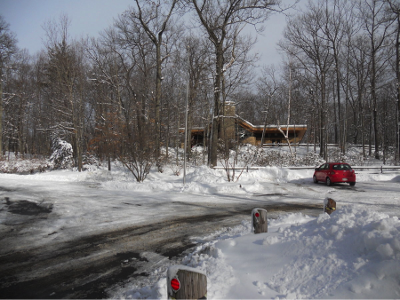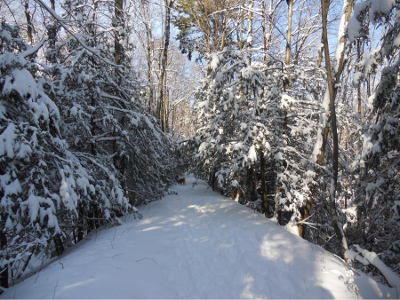By Vivienne Carey
I snowshoed along this trail today and it took about 1½ hours. At other times of the year, when walking at a brisk pace, I usually need a little less than 1 hour. However, as you read on, I will show how the hike can be either shortened or lengthened according to your whim. Begin by parking your vehicle at the Notch Visitor Center on Route 116 in South Amherst and taking the wooden steps up toward the Visitor Center. At the top of the steps, veer right then left to follow the Robert Frost Trail.

The trail is initially quite narrow with small beech trees that are still hanging on to their leaves, which rustle and shake in the breeze. The snow that coats one side of the tree trunks is a clear indicator of the wind direction during last night’s storm.

As you descend a short steep stretch, the path widens and swings to the left. At this point, you have reached the site of the old trolley track along which ran the electric tram that from the early 1900’s linked the town of Amherst to Granby, South Hadley and beyond. However, by the mid-1930’s cars and buses had become so popular that the trolley closed down for lack of business.

Just before turning left along the track, pause to notice Bare Mountain rising on your right, just on the other side of Route 116. Ahead of you is the quarry that since its opening in 1897 has been responsible for the loss of what was once an even higher mountain, but whose fate was sealed when the value of its basalt (trap rock) for road construction was realized. Although current maps name these as Round Mountain and Bare Mountain, local lore relates that they were originally called Great and Little Bear, but that when Great Bear ceased to exist, Little Bear was gradually renamed Bare, with its attendant change of spelling.
The track follows a slight descent northwards as the land drops away on the right with a small pond below. I have been unable to find out whether this pond is natural or was constructed. Perhaps someone reading this will be able to enlighten me.

Keep a look out for informational plaques along the way.
There are many pines and hemlocks that retain a picturesque covering of snow, but also a variety of deciduous trees including locust, with its thick, deeply furrowed blackish bark, and chestnut oak, whose trunk is readily identified by its massively-ridged dark gray-brown bark.

Locust (right)
At the bottom of the long incline the track narrows and shortly after that a path leads right, marked by location badge number 280 up on a tree trunk and a lower hiking trail sign. (Do not confuse this with location number 260, which you will have passed and ignored earlier on). At this point the walk can be shortened by continuing along the main, now narrow, trail, following the power lines until the third utility pole brings you out immediately opposite Atkins Market. If you have had the aforethought to leave a second car parked here, before driving home you may enjoy a cup of hot chocolate or an ice cream, according to the weather.
However, if you turn right along the trail, marked with old yellow blazes, you will have a lovely wander alongside a babbling brook. In snow, this is often a good place to look for the tracks of animals that have been attracted to the water.
Enjoy the peace and silence as you wend your way along the little valley and conserve your strength for the uphill climb to regain the height of the trolley track, where you rejoin it at a little crossroads. Looking back at the path you have just walked along, you will see that it is clearly marked as location number 260.
From here, you can either turn left to return the way you arrived, along the trolley track or, for variety, continue straight through this little crossroads following the narrower trail that leads slightly uphill and passes through stands of mixed evergreen and deciduous trees and some mountain laurels until it reaches the visitor’s center. On the west wall of the center there is a curious relic of former days: a coin operated telephone!
Vivienne Carey is an enthusiastic supporter of the Hitchcock Center who loves hiking with her husband and dog.
Photo credit: Vivienne Carey
